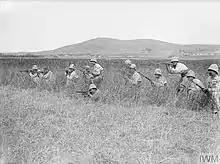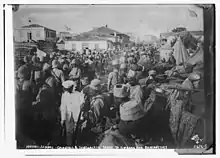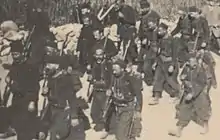156th Infantry Division (France)
156th Infantry Division was an infantry division of the French Army during the First World War. It was deployed overseas, seeing action during the Gallipoli campaign, and thereafter on the Salonika front, fighting alongside British troops in both theatres of war. It was sent to the Crimea in December 1918 as part of the Army of the Danube.
Creation and nomenclature
- March 17, 1915 : Creation of the 156th Infantry Division
- 29 April 1915 : Takes the name of 2nd Infantry Division of the Corps expéditionnaire d'Orient
- 15 October 1915 : Reverts to the designation of 156th Infantry Division[1]
Commanders
- 16 March 1915 : General Maurice Bailloud
- 26 August 1916 - 1 May 1918 : General Baston
- 11 June 1919 - 12 October 1919 : General Dufieux
Order of battle
May 1915

Tirailleurs Sénégalais from a Régiment Mixte Coloniale in French positions on Gallipoli on 15 May 1915

French colonial infantry ('marsouins') from a Régiment Mixte Coloniale practising an advance at Mudros

Marsouins (in pith helmets) and Senegalese (in fezzes) ready to embark for Dardanelles

Zouaves ahead of a column of Greek recruits for the French Foreign Legion, training at Lemnos
2nd Division which disembarked at Gallipoli from 6-8 May 1915
- 3rd Metropolitan Brigade[lower-alpha 1]
- 4th Colonial Brigade
- 7th Mixed Colonial Regiment[lower-alpha 2]
- mixed composition of two battalions of Senegalese Tirailleurs, and one battalion of French regulars known as Marsouins. Both troop types classified as Troupes coloniales.
- 8th Mixed Colonial Regiment[lower-alpha 2]
- mixed composition of two battalions of Marsouins and one battalion of Senegalese
- 7th Mixed Colonial Regiment[lower-alpha 2]
- Divisional Troops
- Groupe Deslions - 3 batteries (4x 75mm field guns apiece) of the 17th Field Artillery Regiment commanded by Captain Deslions[lower-alpha 3] [lower-alpha 1]
- Groupe Mercadier - 3 batteries (4x 75mm field guns apiece) of the 25th Field Artillery Regiment commanded by Captain Mercadier (succeeded by Captain Salin)[lower-alpha 3] [lower-alpha 1]
- Groupe Roux - 3 batteries (4x 75mm field guns apiece) of the 47th Field Artillery Regiment commanded by Captain Roux (succeeded by Major Mercadier)[lower-alpha 3]
- Supporting elements for engineering, logistical and medical services[6][lower-alpha 4]
October 1915
Left the Dardanelles and disembarked on the Salonika front in October 1915.[lower-alpha 5][10] to become part of the Armée d'Orient (1915–19).
- 1st Metropolitan Brigade[lower-alpha 1]
- 175th Regiment
- three battalions of metropolitan infantry
- 1st Provisional African Regiment
- composed of a Foreign Legion battalion and two Zouave battalions.[3] [lower-alpha 6] Both troop types classified as Army of Africa (France)
- 175th Regiment
- 3rd Metropolitan Brigade[lower-alpha 1]
- 176th Regiment
- three battalions of metropolitan infantry
- 2nd Provisional African Regiment
- composed of three Zouave battalions[3]
- 176th Regiment
- Divisional Troops
- Groupe Deslions - 3 batteries (4x 75mm field guns apiece) of the 17th Field Artillery Regiment commanded by Captain Deslions[lower-alpha 3] [lower-alpha 1]
- Groupe Salin - 3 batteries (4x 75mm field guns apiece) of the 25th Field Artillery Regiment formerly commanded by Captain Mercadier (succeeded by Captain Salin)[lower-alpha 3] [lower-alpha 1]
- Groupe Grépinet - 2 batteries (4x 65 mm mountain guns apiece) of the 2nd Mountain Artillery Regiment formerly commanded by Major Benedittini (succeeded by Major Grépinet)[lower-alpha 1]
- Supporting elements for engineering, logistical and medical services
- Corps Artillery:
- 1 Heavy Battery of 120 mm field artillery [lower-alpha 1]
- 1 Heavy Battery of 6x 155 mm howitzers of the 48th Field Artillery Regiment commanded by Captain Kolyczko [lower-alpha 1]
Notes and citations
Notes
- Dispatched in October 1915 from Gallipoli to Salonika with the second division [2]
- Change of regimental name and number in August 1915. The regimental war diary records that from 16 August 1915, it was no longer designated the 8th Mixed Colonial Regiment, but was henceforth the 58th Colonial Infantry Regiment. The same nomenclature saw the 4th, 6th and 7th become the 54th, 56th and 57th too.[4]
- Dispatched in May 1915 to Gallipoli with the second division [5]
- Appendix 3 of the French official history (AFGG 8,1) has a one page table chronologically listing the units that subsequently joined the C.E.O. at Gallipoli.[7]
- Général de Brigade Pierre Dauvé's 3rd Metropolitan Brigade now came under the command of the 156th Infantry Division. From this brigade, the 176th Infantry Regiment and the 2nd Regiment (of Armée d'Afrique) embarked on 30 September and 1 October respectively.[8] Regarding the troops of Colonel Emmanuel Bertrand Alexis Bulleux's 1st Metropolitan Brigade, the 175th Infantry Regiment set sail on 1 October.[8] The 1st Regiment (of Armée d'Afrique) were dispersed. The 2nd battalion (of Zouaves, commanded by Louis Marie Joseph Petitpas De La Vasselais) and the 3rd battalion (of Foreign Legion, commanded by Élie Jean) embarked on the 1st October. The 1st Battalion (of Zouaves, commanded by Jean Louis Urbain Abadie) embarked on the 6th October.[9]
- The four companies of the Foreign Legion battalion were augmented by a further two companies[11] composed of ethnic Greek volunteers forming the 13th and 14th companies of the provisional regiment.[12]
Citations
- Pompé 1924, p. 859.
- "De Gallipoli à Salonique". Forum pages14-18 (in French). Retrieved 8 September 2020.
transcriptions of primary source documents, listing which units redeployed to Salonika
- "Zouaves et Dardanelles". Forum pages14-18 (in French). 12 August 2014. Retrieved 18 August 2020.
- "58e régiment d'infanterie coloniale: J.M.O. 16 août 1915-18 septembre 1916 - 26 N 867/14" (JPG). Mémoire des hommes: Journaux des Unites (1914-1918) (in French). Ministere De la Defense. Retrieved 8 September 2020.
Also contains the war diary for the 8e régiment mixte colonial from the 2 May to 16 August 1915
- Pompé 1924, p. 860.
- "Corps expéditionnaire d'Orient (C.E.O.): J.M.O. 22 février-5 mai 1915: 26 N 75/10 - Pièces justicatives 3 avril-16 septembre 1915" (JPG). Mémoire des hommes: Journaux des Unites (1914-1918) (in French). Ministere De la Defense. images 132 to 136 of 213. Retrieved 10 July 2020.
Ordre de bataille 1 juin 1915 K34
- Lepetit, Tournyol du Clos & Rinieri 1923, p. 547.
- "156e division d'infanterie: J.M.O. 25 septembre 1915-26 novembre 1916 - 26 N 447/1" (JPG). Mémoire des hommes: Journaux des Unites (1914-1918) (in French). Ministere De la Defense. images 9 to 10 of 235. Retrieved 4 September 2020.
- "Corps expéditionnaire d'Orient (C.E.O.): Direction des Etapes et des Services [GHQ Administration]: J.M.O. 5 octobre-31 décembre 1915 - 26 N 76/15" (JPG). Mémoire des hommes: Journaux des Unites (1914-1918) (in French). Ministere De la Defense. image 2 of 21. Retrieved 4 September 2020.
- Lepetit, Tournyol du Clos & Rinieri 1923, pp. 147–148.
- Aspinall-Oglander 1932, pp. 494–5.
- "Greek infantry at Gallipoli". Great War Forum. 10 December 2015. Retrieved 1 September 2020.
References
- Aspinall-Oglander, C. F. (1932). Military Operations Gallipoli, Vol II: May 1915 to the Evacuation. History of the Great War. London: William Heinemann. OCLC 278615923.
- Falls, C. (1996) [1933]. Military Operations Macedonia: From the Outbreak of War to the Spring of 1917. History of the Great War. History of the Great War Based on Official Documents by Direction of the Historical Section of the Committee of Imperial Defence. I (Imperial War Museum and Battery Press ed.). London: HMSO. ISBN 978-0-89839-242-5.
- Jauffret, Jean-Charles (2000) [1996]. "The Gallipoli Campaign: the French point of view" [L'expédition des Dardanelles vue du côté français]. In Gilbert, Martin (ed.). The Straits of War. The Gallipoli Memorial Lectures 1985-2000. The History Press. ISBN 978-0-7509-2408-5.
- Lepetit, Vincent; Tournyol du Clos, Alain; Rinieri, Ilario, eds. (1923). Les armées françaises dans la Grande guerre. Tome VIII. La campagne d'Orient (Dardanelles et Salonique) Premier Volume. (février 1915-août 1916) [8,1]. Ministère De la Guerre, Etat-Major de l'Armée - Service Historique (in French). Paris: Imprimerie Nationale. OCLC 491775878.
- Les armées françaises dans la Grande guerre. Tome VIII. Premier volume. La campagne d'Orient jusqu'à l'intervention de la Roumanie (février 1915-août 1916). Annexes - 1er Volume [8,1,1]. Ministère De la Guerre, Etat-Major de l'Armée - Service Historique. primary source documents (in French). Paris: Imprimerie Nationale. 1924. OCLC 163166542.
- Pompé, Daniel; et al., eds. (1924). Les armées françaises dans la Grande guerre. Tome X. 2e Volume. Ordres de bataille des grandes unités - Divisions d'Infanterie, Divisions de Cavalerie [10,2]. Ministère De la Guerre, Etat-Major de l'Armée - Service Historique (in French) (1st ed.). Paris: Imprimerie Nationale. Retrieved 6 September 2020.
This article is issued from Wikipedia. The text is licensed under Creative Commons - Attribution - Sharealike. Additional terms may apply for the media files.